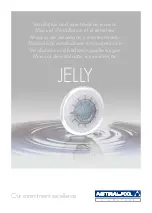
EXPLORE
E3
.
2021 INSTALL & OPERATION MANUAL
14
1. Depending on the model and number of lights installed, you will need to pull the correct sized power cable from
the AC Power (breaker/fuse panel) to the Power Pack locations. Ensure the correct sized tinned marine grade
cable is used to avoid voltage drop issues.
2. Fix Power Pack into required position. Ensure chosen Power Pack location is near enough to connect light cable
without applying undue stress.
Never leave the bare cables unprotected. Take care to not leave the bare wire ends in bilge water before
making the waterproof connections. Water deposits in the connectors and cables will cause corrosion. Over
time water can also work its way into the unit along the inside of the cable due to capillary action causing the
light to fail. This will NOT be covered under warranty.
3. Connect the Power Pack to the AC Power. Ensure the size fuse/breaker, cable and connector have the correct
specification and are watertight. Make sure any heatshrink used completely encapsulates the outer wire sheath
(the use of glue- lined heat shrink is highly recommended to ensure water tightness). Leave the connection
unplugged to eliminate the danger of electrocution.
Corrosion of wire and/or water ingress into the light unit via cable is NOT covered under warranty.
4. Connect the Deutsch connector from the Power Pack to the light using the DC Power Cable.
5. Secure cables ensuring where the cable exits the light it is not under undue stress. Finish and test the light units
BEFORE the vessel goes back into the water.
4.5 FINALISING THE INSTALLATION
The Explore XFM mounting tube is constructed from corrosion resistant Aluminium Bronze and does not require further
protection. The glass is pre-coated with a specialized Tritonium® coating which makes the surface of the glass lens a
non-stick layer.
OceanLED does not recommend that bottom paint or any type of anti-fouling agent is applied to the glass
and/or bezel
, as damage may occur due to chemical incompatibility. However, if bottom painting of the bezel is
deemed essential, then an area of at least 5mm should be left uncoated around the glass lens:
The protective lens sticker should be removed once all work on the vessel is complete.
Coated area
Un-coated area















































